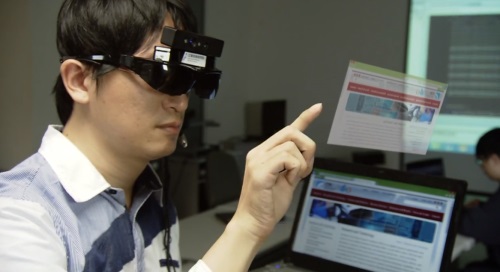Industrial Technology Research Institute (ITRI) introduced i-Air Touch (iAT) technology, a see-through display and air-touch input technology for computers, wearable computers, and mobile devices that allows a user’s hand to be free of any physical device such as a touchpad or keyboard for touch input. The iAT technology enables a user wearing a pair of special eyeglasses to see and interact with a virtual input device, such as a touchscreen or mouse, that appears to be floating in air, while still being able to see and interact with the real world around them. It is available now for licensing by computing, consumer electronics, and mobile companies.
The design allows you to type on the “floating” keypad, keyboard, mouse, or touch panel instead of controlling wearable computers with head movements, voice commands, touching the devices, or entering commands into the app on a smartphone.

i-Air Touch includes three components: see-through eyeglasses, internal camera technology, and an air-touch interface. The see-through eyeglasses display data, images, and input devices to both eyes or only to one eye. The camera scans for and records input, and the air-touch interface relays input from the camera to the eyeglasses displaying a response to the user. The camera technology can be integrated with an existing camera in a wearable computer, and the air-touch interface can be integrated into the firmware and software system of a wearable computer. The DDDR (defined distance with defined range) camera is the key functional component of iAT. It has a phase- and color-coded lens that discerns an object only at a predetermined distance between 28 and 32 cm, and proactively detects and activates only in the presence of a fingertip within input range, shutting off if no fingertip is present. It does not take pictures, but can be integrated with the consumer photographic camera technology of a wearable computer. By detecting that the user fingertip is in input range, the camera ensures that the user is intentionally trying to air-touch the virtual input device and that the camera does not mistake other user movements for input. A successful virtual touch triggers iAT to send a signal to the host device (a computer, laptop, smartphone, etc.) signifying that a key has been pressed or a touchscreen function has been touched.
The researchers think that the iAT technology creates new possibilities for wearable and mobile computing by freeing users from the distraction of locating and touching keys on a physical input device. It is also suitable for medical applications such as endoscopic surgery and industrial applications that benefit from hands-free input.
Commercialization of i-Air Touch is currently underway. The technology is available for transfer to companies worldwide. ITRI holds eight international patents on i-Air Touch technology including in Taiwan, China, and the U.S. Companies interested in licensing i-Air Touch should contact ITRI at 408-428-9988 or . For more information, visit .
Advertisement





